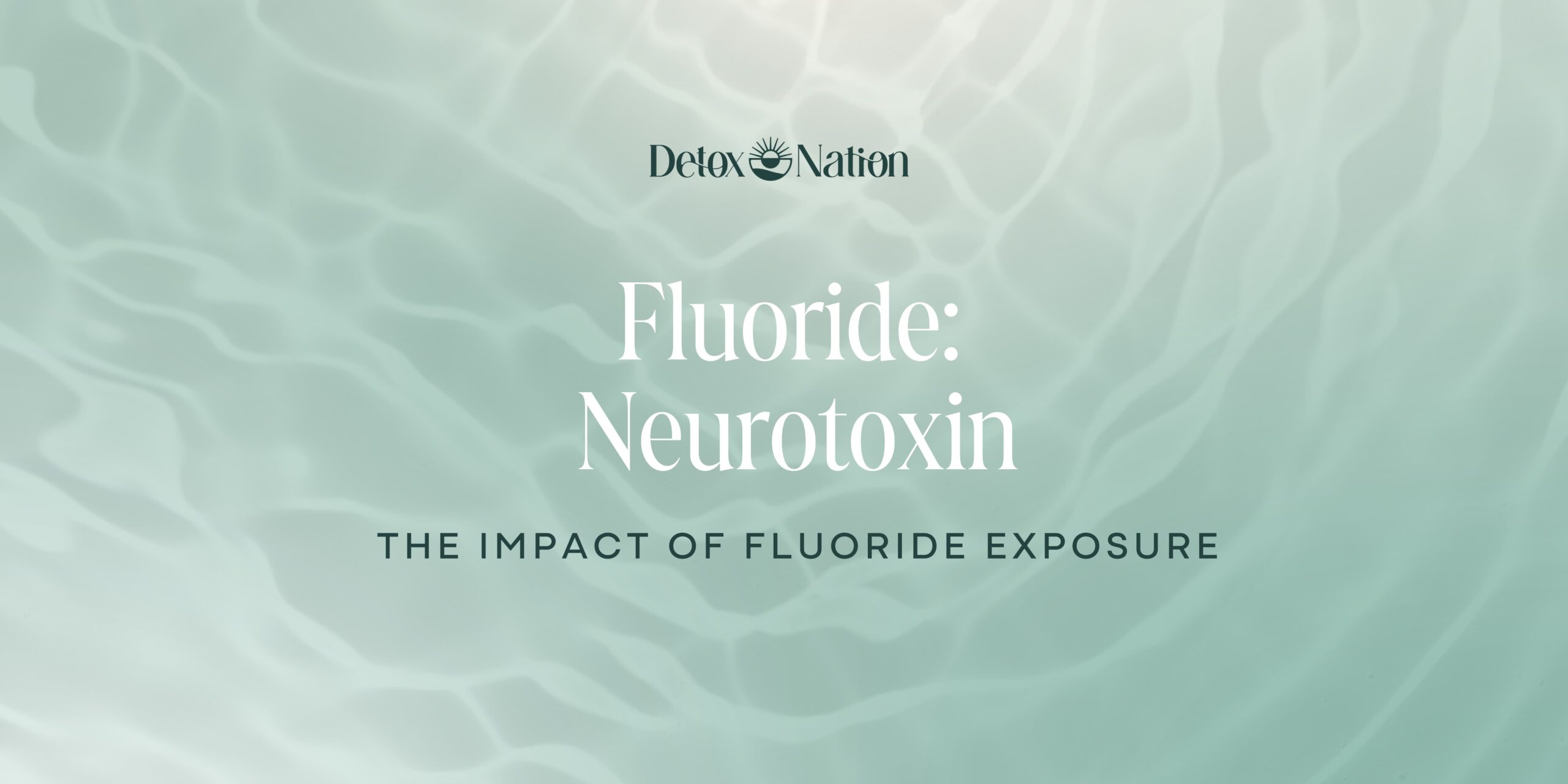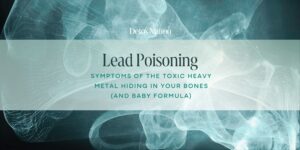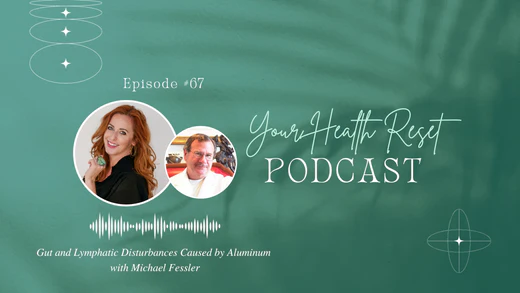Is fluoride a neurotoxin? What’s the impact of fluoride exposure? The National Toxicology Program recently confirmed the neurotoxicity of fluoride and that it causes lower IQ in children. Learn how to protect your family!
You’ve probably heard of fluoride—somewhere between your dentist’s overly enthusiastic pitch for toothpaste and those annoying commercials telling you what “four out of five dentists agree” on.
But, while it was once heralded as a dental hero, this “good guy” might not be such a saint after all.
As it turns out, fluoride isn’t just strengthening teeth—it might be weakening the very foundation of your health.
Imagine this: You’re sipping on a glass of water, thinking it’s all healthy and refreshing, but what if that water is also loaded with something that could impact your brain, hormones, and even sleep?
Fluoride isn’t just a cosmetic issue; it’s potentially damaging your body in ways that could last long after you’ve brushed your teeth.
In fact, some studies even show it could be contributing to issues like ADHD, thyroid problems, and even making your pineal gland calcify.
But don’t worry—it’s fixable. You can take steps to protect yourself, and I’m here to guide you along the way.
Key Takeaways
- Fluoride is commonly found in water and dental products.
- It has far-reaching impacts on brain, thyroid health, and more.
- You can take steps to minimize exposure and mitigate its detrimental effects.

What Is Fluoride And Why Is It In Our Water?
Fluoride is a mineral commonly used in public water supplies to prevent cavities. It’s found naturally in some foods and added to community water systems to improve dental health.
Fluoride Basics
Fluoride is a natural mineral found in various amounts in water and food.
It’s most well-known for its role in dental health, particularly in preventing cavities. I have memories (nightmares?) of the dentist visiting my school and having the kids chew those tablets that turned your teeth a horrifying red in the areas you hadn’t brushed well.
I don’t think they do that anymore—it was marginally traumatic—and I know it wasn’t fluoride but any deep thought on dentistry always makes me think of those tablets!
Now they just “paint” fluoride on your teeth.
When you drink fluoridated water, fluoride is supposed to strengthen tooth enamel, making your teeth more resistant to decay.
This premise is why many communities decided to add it to public water supplies starting in 1945.
Because, apparently, brushing our teeth wasn’t enough—we had to drink fluoride too.
And, despite pockets of resistance from health experts and even some dentists, it has been in US drinking water ever since.
But that may soon change.
In early 2024, Federal Judge Edward Chen (US District Court for the Northern District of California) ruled that fluoride—in drinking water at the current levels—poses an unreasonable threat to human health.
The level of fluoride in drinking water is usually measured in parts per million (ppm).
In the United States, many communities add it to their water to reach around 0.7 to 1.2 ppm.
Why would a Federal Judge think this is harmful? Keep reading to learn more about fluoride, the health effects, and steps you can take to protect yourself.
Fluoridation Compounds in the US
In the United States, fluoride is added to water supplies through compounds like sodium fluoride, sodium fluorosilicate, and fluorosilicic acid (4). These are known as “industrial fluorides.”
Fluorosilicic acid is a vapor byproduct of phosphate fertilizer manufacturing.
This acid can be neutralized with caustic soda (a water treatment chemical) to create sodium fluorosilicate, the second compound used in water fluoridation.
Sodium fluorosilicate is used as/in enamels, insecticides, rodenticides, leather preservative, gelling agents, soaps, and glues. It’s also used to produce latex foam (14).
According to the national chemical database (PubChem), sodium fluorosilicate is toxic if ingested or inhaled (14).
Alternatively, the fluorosilicic acid vapor can be neutralized with sodium chloride (salt) to create sodium fluoride, the third compound used in water fluoridation.
Honestly, none of those sound like anything I want to put in my mouth.
Industrial fluoride ingested from treated water was found to be at levels too low to impact cavity formation (11), so why do we still have it in our water supply?
Other Sources of Exposure
Besides drinking water, you can find fluoride in certain foods and drinks (20).
Packaged foods like cereals, canned soups, canned tomato products, and canned vegetables often contain small amounts of this neurotoxin.
Spinach, carrots, asparagus, white potatoes, radishes, and celery too.
Beverages like soda, fruit juices, and tea also include it, which can increase your daily intake. Even dill pickles naturally contain some fluoride.
Metabolism In Your Body
Once ingested, approximately 80% is absorbed in your gastrointestinal tract and eventually enters your bloodstream (15).
About 50% of the absorbed fluoride is stored in the bones and teeth. It’s claimed that the rest is cleared from your body through urine (15).
Now that we have a little background information, let’s look at the health impacts of fluoride.
Fluoride As A Neurotoxin
Fluoride has attracted attention for its potential risks as a neurotoxin.
Neurodevelopmental and Cognitive Health Effects
Did you know fluoride exposure could be harmful to our brains? (As if we needed another reason to question everything we’re exposed to daily.)
Research shows that fluoride can impact neurodevelopment, and it might even be on par with heavy hitters like lead when it comes to lowering IQ in kids (1, 8, 9, 10, 22, 23).
As if kids these days don’t have enough to deal with already.
Here’s the thing: prenatal fluoride exposure might have serious ripple effects on cognitive development.
One study found that every 1% increase in artificial fluoridation prevalence was associated with 67,000 to 131,000 additional ADHD diagnoses over an 8-year period (2).
That means these exposures during crucial periods could lead to long-lasting brain fog or worse.
So, while we’re all out here worrying about screen time or getting our kids to eat something green, fluoride might be quietly throwing a wrench into cognitive performance behind the scenes.
Let’s add “filtering fluoride” to the never-ending list of things to think about—right after figuring out how to create enough time in the day to make healthy meals.
Fluoride and ADHD
Fluoride and ADHD—who knew?
Turns out, some researchers are raising eyebrows about the connection between high fluoride levels and behavioral challenges like ADHD (2, 23).

Apparently, fluoride isn’t content just hanging out in toothpaste—it might be compromising brain development too. (Great. Just great.)
The idea is that it’s neurotoxic effects could disrupt normal brain functions, which might explain some of the behavioral issues we’re seeing more of these days.
The National Toxicology Program’s Monograph
The National Toxicology Program (NTP) has evaluated fluoride in terms of neurotoxicity.
In their comprehensive monograph, it is considered a human developmental neurotoxicant, meaning it can disturb the development of the nervous system.
The NTP looked at 72 human studies and highlighted concerns about fluoride’s impact on cognitive functions.
They determined that 95% of the high-quality studies reviewed demonstrated an association between fluoride levels and lower IQ in kids (21).
Meaning, as exposure increased, IQ decreased.
As if parents don’t already have enough on their plates—thanks, fluoride!
What else can fluoride do in our bodies? So glad you asked!
We’ve even made it easy for you to get started with a Fluoride Kit, designed to support your body, mitigate, and reduce fluoride exposure.
Cheering you on every step of your journey!
Check Out Our Fluoride KitKnown Health Effects Of Fluoride
Fluoride has various effects on different bodily systems. Some areas of concern include reproductive health, thyroid function, bone health, and the pineal gland’s role in regulating melatonin production.
Reproductive Health And Fertility
Oh, fluoride, what can’t you mess with?
Spoiler alert: It’s not reproductive health.
Research suggests that fluoride exposure can disrupt testosterone synthesis and produce sperm deformities in men (17).
Yep, we’re talking hormone imbalances that could lead to fertility issues (17).
Because clearly, this little chemical didn’t get the memo to stay in its lane.
Animal studies back this up, showing it can cause some unwelcome surprises in the reproduction department—for both sexes.
Scientists are still piecing together exactly how it pulls off this unwanted party trick, but the takeaway is clear: keeping levels in check might be more important than we thought for protecting fertility. Fun, right?

Thyroid Function And Metabolism
The thyroid gland—our little metabolic maestro!
Unfortunately, fluoride seems to have a knack for throwing a wrench into its performance.
Here’s the deal: your thyroid depends on iodine to do its job, and it can swoop in and disrupt iodine absorption (8, 22).
The result? Potential hormone imbalances, like low T3 or elevated TSH and even thyroid nodules, which can pave the way to hypothyroidism (6, 7, 8, 16, 22).
Cue the brain fog, fatigue, and that “why-am-I-always-cold” feeling.
Chronic exposure to high fluoride levels might even up your chances of developing metabolic disorders.
And while no one is safe from its meddling, some folks—depending on their diet or access to health resources—might be more at risk.
Bone Health
Fluoride is naturally found in bones, but excessive amounts can lead to skeletal fluorosis, a condition that can damage bone structure.
This overexposure affects bone density and strength and might increase fracture risk.
While it aids in bone formation, too much can cause toxicity and might even lead to brittle bones over time (11).
Excessive amounts can also lead to dental fluorosis, a cosmetic discoloration of the teeth that might make your child embarrassed to smile (24).
Soft tissue fluorosis can impact the brain, heart, liver, and kidneys (25).
Pineal Gland And Melatonin
Let’s talk about your pineal gland—your brain’s very own “sleep whisperer.”
This little powerhouse produces melatonin, the hormone that keeps your sleep patterns in sync.
But here’s the plot twist: fluoride likes to hang out in the pineal gland, and when it sets up camp, it can throw your melatonin levels out of whack (19).
The result? Messed-up sleep rhythms and that fun “I need 17 cups of coffee to function” kind of fatigue.
Worse yet, chronic exposure can lead to calcification of the pineal gland, essentially turning it into a rock star in all the wrong ways (19).
This calcification can disrupt its ability to function properly, potentially causing long-term sleep issues.
Emerging Health Effects of Fluoride
Fluoride exposure can lead to several emerging health effects related to body systems and essential nutrients. Researchers are keenly observing how it impacts areas like your gut’s microbial balance, oxidative stress, and the balance of heavy metals and nutrients in your body.
Microbiome
Let’s talk about your gut—home to trillions of bacteria throwing the ultimate wellness party (or disaster, depending on the guest list).
Your microbiome is a big deal.
It handles digestion, boosts your immune system, and generally keeps things running smoothly.
But fluoride exposure might crash the party, upsetting the delicate balance of your gut bacteria.
Studies hint that it can alter both the diversity and composition of your microbiome (1).
Translation? The good guys might get outnumbered, leading to chaos like inflammation, digestive issues, or worse.
Oxidative Stress
Oxidative stress might sound like something out of a sci-fi movie, but it’s just your body trying (and sometimes failing) to keep up with the chaos caused by free radicals.
These troublemakers can damage proteins, fats, and even DNA when they run unchecked.
Fluoride exposure? It’s like handing free radicals extra fuel for their mischief.
Fluoride may increase oxidative stress, throwing your body’s balance off and opening the door to all kinds of unwanted drama—think neurodegenerative diseases or even cancer (12, 26, 27).
This kind of cellular mayhem can disrupt normal body functions, and let’s face it: nobody has time for that.
Heavy Metals and Nutrients
Fluoride interacts with heavy metals like lead and essential nutrients such as calcium, zinc, and selenium.
It can even enhance the absorption of some heavy metals, potentially leading to toxicity.
One study found a 1.7-fold increase in strontium levels, and a 1.4-fold increase in lead levels in kids with chronic fluoride exposure (18).
The same study found a 14-fold decrease in copper, a 2.5-fold decrease in calcium and zinc, and a 2-fold decrease in selenium (18).
What impact would these deficits have on a developing child?
How would these imbalances disrupt vital bodily functions?
The Dental Debate
When you think about this neurotoxin, it’s often seen as a savior for teeth. But there’s a lot more to the story when you look closer. You’ll see not just benefits, but costs that don’t get the same spotlight.
Fluoride’s Limited Benefits
Fluoride is famous for fighting dental caries, mainly through its use in toothpaste and water fluoridation.
This mineral helps by hardening enamel and making teeth less prone to decay.
I would argue that topical application, directly to teeth, seems to be a more direct and effective use than the involuntary mass-medication of an entire population (9).
Or even better, develop dietary, health, and oral hygiene habits so your teeth are strong and protected from the inside-out! Topically applied it can also densify tooth enamel beyond optimal levels, making teeth more prone to chipping later in life.
The Hidden Costs: Fluorosis
As mentioned previously, one downside of fluoride that’s often overlooked is dental fluorosis.
This is a condition resulting from too much exposure to it during the early years of life (11).
It causes changes in tooth enamel and can range from minor spots to significant discoloration, often viewed as cosmetic but sometimes more severe.
Fluorosis is often masked in discussions about it, but for some, it becomes a personal concern, especially for children who are particularly sensitive about their appearance (28).
Potentiation With Other Molecules
Fluoride doesn’t exist in isolation; it can interact with other molecules in your body.
This potentiation can sometimes amplify effects, both good and bad.
In certain environments, it could react with other elements and potentially pose risks to the nervous system.
For example, it can interact with calcium, magnesium, and iron supplements (5).
And there’s the possibility that it could interact with prescription medications, industrial chemicals, and food additives.
Now that we’ve looked at the dangers of fluoride exposure, let’s explore some simple ways you can protect yourself!

Steps To Protect Yourself
Minimizing exposure can help your health. This section covers how distilled water, fluoride-free toothpaste, and nutrition are practical steps to limit intake.
Distilled Water
Distilled water is purified and fluoride-free, which makes it an easy option if you’re looking to minimize exposure.
Switching to distilled water is a straightforward way to reclaim a bit of control over what’s going into your body.
You can grab it at the grocery store or go full DIY with a home water distiller—cue your inner mad scientist.
But before you start toasting to your fluoride-free future, remember that distilled water is a bit of a blank slate—it doesn’t have any minerals.
The solution? Pair your distilled water habit with a mineral-rich diet. Think leafy greens, nuts, and seeds if you can tolerate them, and use bioavailable mineral supplements to fill in the gaps. Balance is key, as always!
Mind Your Toothpaste
Choosing the right toothpaste is crucial in controlling fluoride exposure.
Many toothpastes contain fluoride, but there are alternatives.
Opt for fluoride-free toothpaste to lower intake. (This is my favorite one.)
Look for labels that specifically state “fluoride-free” to be sure of what you’re using.
Once you have the right toothpaste, aim to brush and floss twice a day, and see a mercury-free biological dentist to keep your pearly whites healthy!
Nutrition Matters
Let’s talk food (one of my favorite subjects) and how it can help your body kick fluoride to the curb.
Of course, it makes sense that you should avoid sugars and processed foods, right?
But there’s more to it.
Turns out, certain nutrients are like your internal clean-up crew, helping your system handle it more effectively.
Foods rich in selenium, magnesium, and iodine are particularly helpful—think organic nuts, seeds, and wild-caught, properly-sourced seafood.

Support Your Body
Fluoride negatively impacts virtually every system in your body, so they all need extra love to mitigate its effects.
What kinds of things can help?
- Iodine: Supports your thyroid gland, metabolism, and hormones.
- Boron: Hormone, immune, and brain support. Also helps reduce inflammation.
- Selenium: Thyroid and antioxidant support for metabolism and energy.
- Magnesium: Promotes energy production, better sleep, digestion, brain health, metabolic health, and hundreds of biochemical reactions in your body. (But be careful!! The wrong type of magnesium can do more harm than good.)
- Fulvic and Humic Acids: These amazing acids—when used at the right time and in the right combinations—can help detox toxins and heavy metals, support the immune system, reduce pain, and promote balance on a cellular level.
- N-Acetyl-Cysteine: A powerful antioxidant and detox agent.
- Melatonin: Circadian rhythm and sleep cycle support. (If you can’t get restful sleep, you can’t heal!)
While all the above can help, it’s critically important to use only high-quality, vetted products. Ones that are safe, undergo third-party quality testing, use the best sources, and are effective.
You don’t want to add to your toxic burden while trying to detox!
How do you find those products?
Spoiler alert: We’ve created a Fluoride Kit that has all of that figured out for you!
You can maximize your results by combining it (when appropriate and tolerable) with our Energy Kit and Drainage Kit.
Conclusion
So, there you have it.
Fluoride isn’t just the toothpaste wonder drug we were all led to believe.
It’s quietly making a mess of our bodies in ways we didn’t sign up for.
From interfering with brain function to throwing a wrench in hormone production, it is definitely not just a “dental care issue.”
It’s a full-body health issue that deserves a lot more attention than it’s been getting.
Here’s the good news: it’s not all doom and gloom.
You can take steps to minimize your intake and regain control over your health.
Swap out that tap water for distilled water, switch to fluoride-free toothpaste, and feed your body the nutrients it needs to flush out the excess.
We’ve even made it easy for you to get started with a Fluoride Kit, designed to support your body, mitigate, and reduce exposure.
Cheering you on every step of your journey!
We’ve even made it easy for you to get started with a Fluoride Kit, designed to support your body, mitigate, and reduce fluoride exposure.
Cheering you on every step of your journey!
Check Out Our Fluoride KitFrequently Asked Questions
Fluoride is a hot topic these days, especially with concerns about its effects on health. Let’s dive into some common questions about fluoride, its impact on the brain, and the controversies surrounding it.
What are the known side effects of fluoride in drinking water?
When it’s added to drinking water, it aims to prevent tooth decay. However, high levels can lead to dental fluorosis, which affects the appearance of teeth. Many studies and systematic reviews also suggest potential links to bone issues and other health concerns.
How can fluoride exposure affect a person’s cognition?
Recent epidemiological studies state fluoride is a developmental neurotoxin that impacts children’s intelligence. It’s often grouped with other known toxic substances like lead, based on some meta-analysis findings.
What is the corporate influence on fluoridation programs?
Corporations have played roles in promoting water fluoridation, sometimes leading to claims of a conflict of interest. Some feel that their influence might sway public health recommendations. Critics stress the need for transparency and strict guidelines to ensure decisions are based on unbiased risk assessments and adequate intake standards. Others contend that corporate backing helps support public health initiatives by providing necessary resources.














